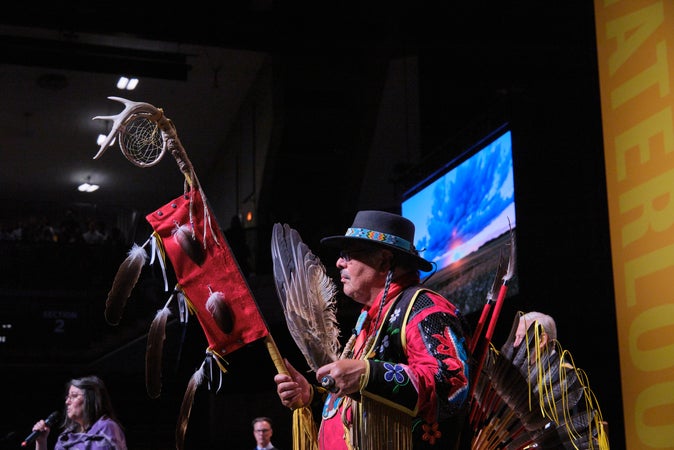Eagle Staff
An Eagle Staff is a sacred symbol of wisdom, strength, and honour, representing the Indigenous relationship to the Earth and those who protect it. It carries the spirit of Indigenous traditions and is cared for by the Indigenous campus community.
By welcoming the Eagle Staff, the University acknowledges its responsibility to recognize and incorporate Indigenous perspectives in teaching, governance, and institutional conduct. The Eagle Staff holds a prominent place at Waterloo ceremonies, like convocation, honouring First Nations, Métis, and Inuit community members, their cultures, and strengths.
“The Staff will serve as an important symbol and reminder of the commitment we made to reconciliation and serve as inspiration for our university community today and for future generations.” – Vivek Goel, president and vice-chancellor.

Waterloo Region is situated on territory traditionally shared by Anishinaabeg, Neutral (or Attawandaron), and Haudenosaunee Nations. Though many nations, including the Anishinaabeg, involve an Eagle Staff in their traditions and practices, we respectfully acknowledge that this is not the practice of all nations. With gratitude, we honour and celebrate the unique traditions of all First Nations, Métis and Inuit people, and look forward to reflecting this diversity in spirit and custom as we move forward on this path of decolonization, Indigenization, and reconciliation.
University mace

This solid silver and ebony wand was given to the University in 1965 by the family of the late Stanley F. Leavine and was designed by Toronto artist Eric Aldwinckle and crafted by silversmith Harold Stacey to symbolize the University as it was at that time. It displays lions, chevrons and the shield of the province of Ontario, from which the University holds its charter to grant degrees.
The symbolic theme of the mace is unity amid diversity, and tension in the creative intellectual process that strives to bring forth a new individual. The design of the mace interprets this theme in the idiom of the life process: from the seeds at the base of the stave, the mace grows in unity and strength until it differentiates by a four-fold separation into diverse elements.The four-fold diversity is significant because of the four faculties existing at the time the mace was presented to the University and as well of the four church-related colleges federated and affiliated with the University. These diverse elements together form a crown, and the points of the crown, while tending toward a union do not quite touch. They remain as individuals suspended in tension and yet engaged in a deep harmony. This creative process is focused not on the traditional spherical orb of static perfection but rather on an elliptical silver ovum — the egg-shaped symbol of creativity — the marvelous potential of a new individual life.
University arms and motto
The lions and chevrons also appear on the shield that is the University’s coat of arms. This design is also imprinted on the graduates’ diplomas. Derived from traditional heraldry, it has been used since 1961 and was registered with the Court of the Lord Lyon in 1987. The shield uses the official colours of gold, black and white, and its symbols refer to the University’s base in the cities of Kitchener and Waterloo. The unusual double chevrons were borrowed from the coat of arms of Lord Kitchener of Khartoum, and the red lions are like those on the coat of arms of the Duke of Wellington, victor at the 1815 Battle of Waterloo. The lions also reflect the tough and innovative spirit of the University’s founders and builders, and the black and white in the chevron are the colours of Prussia, reflecting the Germanic background of many Waterloo County settlers. Beneath the shield appears the University’s motto, “concordia cum veritate,” — meaning, in harmony with truth.
Ceremonial Seal

Degree information and regalia

Doctoral (PhD) graduates will cross the stage one at a time, while master's and bachelor's level graduates will cross three at a time.
Note: Graduates having received their diploma via the early degree process will not receive another diploma at the ceremony.
The academic regalia chosen for the University of Waterloo is patterned after that of the University of Oxford (except where noted).
Medal and prize winners
Following the presentation of degrees and diplomas, medal and prize winners (including the Governor General Awards, Alumni Gold Medals and other student awards) will be called to the stage to receive their awards.